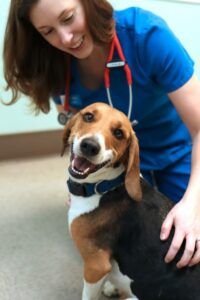- What does it cost to have my pet seen at Mountain View Animal Emergency?
The emergency examination fee is $190.00. Anything further will have an additional cost. This can include but is not limited to, diagnostics, treatments, medications, etc. You will receive an estimate and treatment plan prior to the veterinarian performing anything more than the examination. This is generated by the veterinarian and is a way for you to know what to expect financially. We accept many payment options, such as cash, credit cards, checks, and programs that include Care Credit, All Pet and Scratchpay. We do not provide any billing options, and payment is due in full at the time services are rendered. If you would like additional information on Care Credit or Scratchpay, please see the listed websites:

- What should I bring when coming to Mountain View Animal Emergency?
For safety purposes, we ask that all felines are in carriers and all canines are on leashes with a properly fitted collar. We would not want your pet to slip their collar or jump from your arms, which could possibly cause them more harm. If your pet currently takes medications or has pertinent medical paperwork, then please feel free to bring this with you as well.

- What should I expect when I arrive at Mountain View Animal Emergency?
We operate similar to the human emergency room in that we do not offer appointment times. You must call prior to your arrival so that we can go over our protocols and inform you of our current wait time. Please be advised that wait times have increased significantly due to the volume that every veterinary hospital is encountering. Due to the caseload, we may not be able to accommodate walk-ins. If this happens, we may have to refer your pet to another hospital if we are at capacity.
If we are able to see your pet, we ask all customers to call the hospital once they arrive in the parking lot. The Client Service Representatives will place you in an examination room. They will also assist you in filling out the necessary paperwork. After your pet has been checked in, a veterinary technician or assistant will either meet you in the examination room or call the phone number you provided and speak with you to collect information about your pet’s condition. The veterinary technician or assisstant will then obtain the vital signs from your pet and the veterinarian will perform the examination. The veterinarian will then discuss a treatment plan with you after the examination is complete and will move forward accordingly.
- What constitutes a pet emergency?
Pet emergencies can vary greatly depending on multiple factors. It is always best to consult a veterinary professional if you are concerned about the health of your pet. Some symptoms that may require emergency attention are:
- Vomiting and/or diarrhea that last over 24 hours or has the presence of blood.
- Sudden bloating of the abdomen.
- Sudden collapse.
- Seizure (specifically more than one in 24 hours’ time).
- Difficulty breathing.
- Bleeding from any area.
- Unexplained and/or untreated pain signs.
- Straining to urinate or defecate and/or blood in urine and/or feces.
- Frank trauma (such as falls, hit by cars, animal fights, broken bones).
- Accidental poisoning, overdosing, or toxic ingestions.
- Difficulty with birthing.
*Be careful when handing painful or disoriented pets. A pet’s behavior can become unpredictable when pain, fear, or disorientation has occurred. Sometimes the use of blankets, towels, or carriers/kennels can be used to help move pets.
- Will my pet be alone during treatments or after being hospitalized?
No, we monitor all of our patients for the entirety of their stay at Mountain View Animal Emergency. At no point are they left unsupervised. We have a doctor, several technicians or assistant with your pet 24 hours a day.
- If my pet is hospitalized, will I be able to see them before I leave? When will I receive updates on my pet’s condition?
In most cases, if your pet is being hospitalized, you can ask to see your pet before departing from Mountain View Animal Emergency. Depending on the situation, we also ask that visitations last about five minutes. This allows us to start your pet’s treatments in the most time-sensitive way possible. We understand how difficult it can be to leave your pet in someone else’s hands, and we do our best to make each pet feel safe and comfortable during their stay with us.
A veterinarian will reach out to the primary contact on your account twice a day (morning and evening) to give you a detailed update on your pet’s case. You will be asked to leave the phone number that is best to contact you with. You are welcome to leave additional phone numbers if another is needed. If something changes with your pet’s status, we will alert you as soon as possible. You are welcome to call us to receive updates on your pet’s condition whenever you desire. We are answering our phones 24/7. If you would like to come visit, please call before arriving to ensure you can visit your pet promptly.
- Will my regular veterinarian receive updates on my pet’s condition?
- What animals does Mountain View Animal Emergency see? What should I do if I find a stray pet or wildlife?
Mountain View Animal Emergency only sees felines and canines. We do not see exotic/pocket pet animals.
If you find a stray dog or cat, you should first contact animal control and report the stray animal. Do not pick up or handle any stray/unknown animal, especially if it is acting aggressive due to the risk of being injured.
If you find any wildlife animals, do not touch them. Leave the animal exactly as you found it. Most likely, the mother will return to the animal. If the animal is injured, then contact animal control or wildlife rescue for assistance.
- Can I give my pet Over-the-Counter medications?
There are many factors that should be considered before giving your pet over-the-counter medications. Below is an abbreviated list of over-the-counter medications that can be used. When in doubt or if symptoms worsen, always consult with your veterinarian.
- Diphenhydramine (Benadryl) is an antihistamine that can relieve allergy symptoms. These can cause drowsiness or hyperactivity in your canine. Make sure the medication only contains an antihistamine and no other ingredients that are unsafe for canines.
- Tylenol, Ibuprofen, and most human NSAIDs are NOT safe for canines or felines. Tylenol can cause liver toxicity and amongst other issues, ibuprofen and other NSAIDs have the potential to cause increased risks of gastrointestinal bleeding, stomach ulceration, kidney damage, and even neurologic side effects.
- Artificial tears can be used if your canine appears to be squinting, having dry eyes, or possibly have some dust in the eye. This lubricant can safely provide some relief for the eyes, but if the symptoms persist then consult with a veterinarian.
- Topical antibiotic ointment, such as Neosporin, can be used on minor cuts or abrasions to help wounds heal. Be sure to clean the area of trauma first before applying. If the wound continues to bleed or appears to become infected, seek veterinary care immediately.
- A “Skunk bath” recipe can be made up at home if your canine had the unfortunate event of being sprayed by a skunk. To make: mix ¼ cup baking soda, 1-2 teaspoons of mild dishwashing detergent, and 1 quart of 3% hydrogen peroxide solution. Mix in a bucket and use it immediately to bathe your pet. Leave on your dog’s fur for five minutes and then rinse with warm water. You can then wash your pet with dog shampoo if you desire.
- My canine/feline has been in labor for a long time. When is this an emergency?
If your pet has been actively in labor for 60 minutes or more without delivering her first baby, or if a baby remains in the birth canal for more than a few minutes without advancing, then emergency medical care should be sought after.
If your pet has weak contractions/straining for greater than two hours without a baby, or if there has been no baby delivered for over four hours after birthing has started.
If you find lochia (green/black vulva discharge) present for three hours without a baby being delivered, if you see any copious clear vulva discharge, or if you find bloody vulva discharge, then you should seek veterinary care.
- My pet is a Diabetic. Should I give my pet its insulin if they are not eating?
You should not give your pet its insulin if they are not eating. This can cause their blood sugar to drop and cause hypoglycemia. Hypoglycemia can be very serious and cause seizures, a coma-like state, and even death.
The best practice is to make sure your pet is eating at the correct time interval, the correct amount of food, and that other pets in the house are not eating the diabetic pet’s food. It is best to give the insulin after the pet has eaten. That way you know they ate all their food before medicating them.
If they are refusing to eat, try warming up their food or hand-feeding their food to them. Be sure that the food is not old (especially if it is a wet food that has been sitting out for over an hour). If it is then change it out for fresh food.
If this does not encourage the animal to eat, then it is best to contact your veterinarian for additional advice.

- What should I do if my neonatal kitten/puppy is lethargic and not wanting to nurse?
Your neonatal kitten or puppy could be experiencing “fading puppy/kitten syndrome” which can be caused by many different types of illnesses. If your puppy or kitten is not acting normal, is vocalizing more, is sleeping away from the litter, appears to be losing weight, or appears to be declining, then contact a veterinarian immediately for additional advice.
- Should I be concerned about contagious diseases with my pet?
Diseases that are transmissible between animals and humans are labeled as zoonotic. Some zoonotic diseases that can be spread to humans are hookworm, giardia, toxoplasmosis, roundworm, ringworm, salmonellosis, rabies, etc. There are minimal risks that humans will become infected with these diseases when good hygiene is practiced.
The best way to minimize your chance of becoming infected is to practice thorough hand washing techniques, wear gloves when cleaning fecal matter or urine, keep your feline’s litterbox away from where you would prepare food and scoop it daily, try not to aerosolize the litter when dumping it (dump it slowly or use disposable litterbox liners that can be thrown away), do not touch wildlife or stray animals that are acting strange, and to properly vaccinate your own animals according to your veterinarian’s advice.
Frequently Asked Questions
What our patients are saying...
“If your pet is truly in trouble head here! They literally brought my cat back from death's door. Dr Mostoller was so patient & compassionate when I was at my worst! Answering every question even tho she was busy! Dr Foy was so kind and thorough! She got to the probable root of the problem quickly! Tidbit & I are...”
Jennifer Marsters“Took my cat Mara there today. Staff was absolutely wonderful and DVM Julie Augustine was wonderful also! She went from not eating and drinking to eating wet food drinking water and already trying to use the bathroom the same night. They gave her a fighting chance. If I could rate higher then 5 stars I would. Yes you have to...”
Ray K“I could not be more thankful for this place, my pup got deathly sick from a piece of table food, but Mountain View truly saved my baby I can say. When she had to stay the night, they were so patient and kind, they let us check in with her any time over the night, no problems. From the front...”
Jenna McLeod“The drs & staff took wonderful care of our sweet lab Morgan. They called keeping us updated every step of the way . Unfortunately Morgan did not make it but the staff was very compassionate and caring during our extremely difficult decision. Thanks to everyone !! We loved you so much Morgan <3”
Tammy Knott

Navigation
Helpful Links
Follow Us
Open on all major holidays!
Please call our hospital so we can help direct your pet's care before arriving.


